
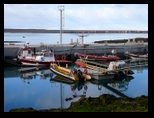
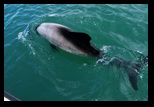

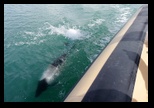
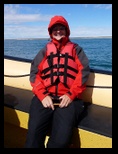
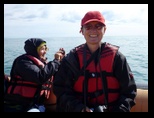
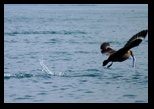

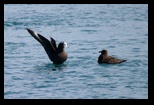
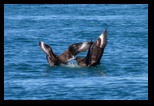
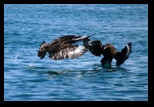

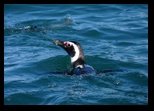
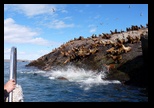

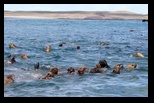
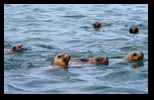
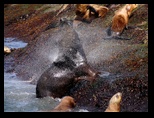
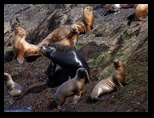
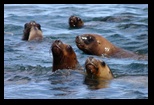
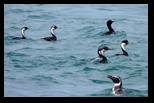


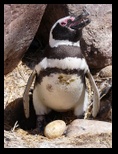
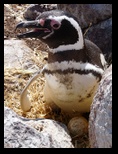
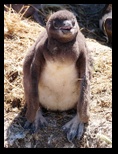

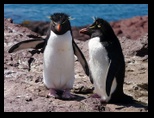
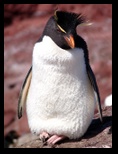

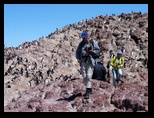
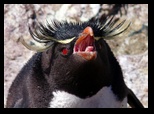
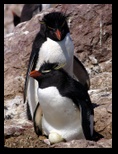
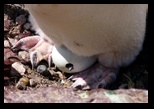
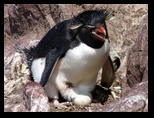
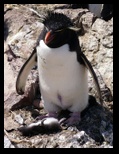
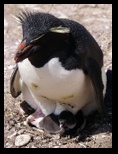


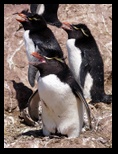
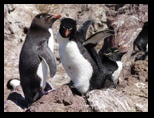
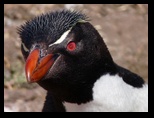
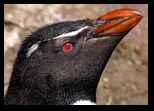
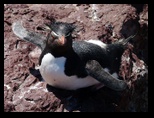
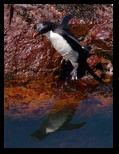
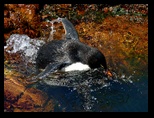




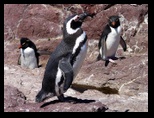
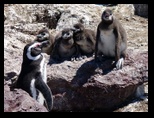
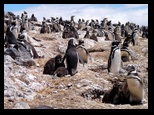
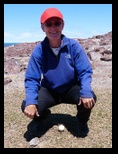

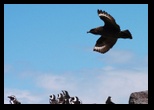

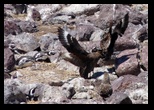



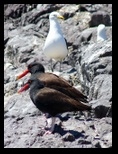
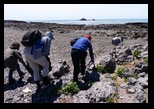
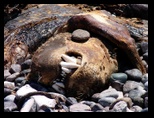

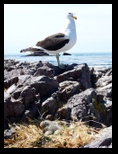
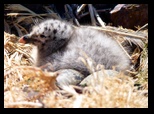
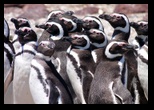
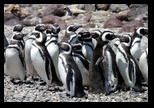
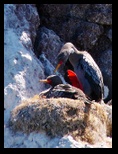

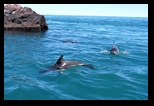
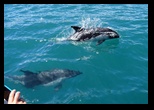
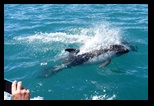
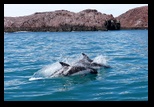
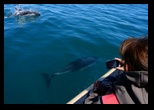


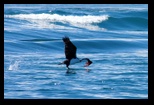

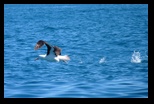
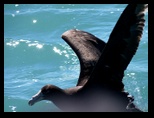
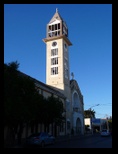



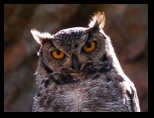


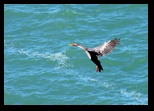
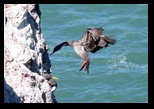

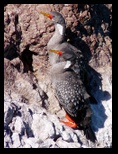


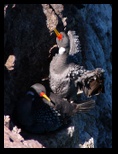
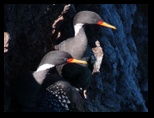
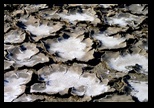

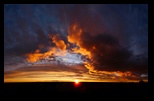
Click on a photo to enlarge it.
When we started driving off the petrol station car park there was a huge queue of lorries along Highway 3 heading south. The road was completely blocked so we turned left to see if we could find a way out and were directed by police officers up a steep road towards the town. There were no signs so it was a good job we had GPS!
We followed other cars along dirt and gravel roads and even past the local rubbish tip. We were taking the scenic route! After stopping at a supermarket we tried to get out of town and found out that the road block was caused by lorry drivers protesting low wages. At least cars could get through but then we got totally confused because there is obviously a new road being built. Its not finished yet and we couldn't tell if we were allowed to drive on it or not. There were no signs and at one point we drove around a traffic island twice before we worked out which way to go! We basically just followed the route that the majority of other traffic used and finally got out of town and back onto Highway 3.
Just out of town we stopped to take a look at a group of younger male sea lions on the beach and then continued south and turned off the main highway to drive out to the coast to get to Puerto Deseado.
Sea lions south of Caleta Olivia
We didn't get there until 8-10pm but Darwin Expeditions, who run boat tours out to Isla Pingüino and along the river were still open. So we went inside and spontaneously booked a boat tour for the following morning at 9am. It only took 10 minutes but cost us $85 each!!
The tours are really expensive but it had been recommended by others. The advice was that if we wanted to only do one boat trip we should choose this one. It turned out to be really good advice. We were allowed to park on their car park overnight and packed a small rucksack and made a flask of tea for the trip.
At 9am we met our tour guide Roxana and boat captain Xavier along with 6 other passengers - a couple from Sao Paulo, Brazil, another couple from Santa Fe, Argentina and Manfred and Gaby from Germany whose vehicle we've seen along our route but have never met them. Their names had been mentioned by others though and when we introduced ourselves they said "Oh, your Helen and Kirsten!" They'd obviously heard of us too!
Roxana is an excellent tour guide. She's originally from Buenos Aires but has worked at a hotel on Península Valdés for the last 13 years. She came on this boat trip two years ago and decided she wanted to be a guide here. She's been here for the last 12 months. Her enthusiasm for the tour and the wildlife was infectious and we were all looking forward to the trip.
It started off really well - within minutes we saw Commerson dolphins (Tonina overa) which are the smallest dolphins and so quick that we all had trouble getting photos and video. They were darting around and under the boat. So I just had to guess where they might come above the water, point the camera there and switch on the video. It worked!
There were also a large group of skuas, Imperial cormorants and terns diving for anchovies and other fish and this was all before we even got to the island 30km away from Puerto Deseado.
Getting off the boat and onto the island was a bit awkward because of the swell of the waves and the slippery rocks we had to climb over but we were greeted by a large group of Magellanic penguins.
We walked past a defunct seal factory where seals used to be killed for their skins and oil. The old lighthouse has partially collapsed and the penguins now use it for nesting. Then we walked over the rocks to see Rockhopper penguins, so called because they are far better at jumping over rocks. They have recently been counted and there are 1.120 pairs here.
Rockhoppers arrive here in October, a month later than the Magellanic, and lay two eggs. The first is smaller and doesn't survive. The second egg is always bigger and the incubation period is only 30 days (40 to 42 for the Magellanic) We saw a lot of eggs and one that looked as if it was about to hatch. There were also a lot of chicks at various stages of growth. It's a sad fact that only 50 percent will survive to return next year.
We walked across the island to see sea lions and a couple of elephant seals but had to wave our arms above our heads as the skuas are very aggressive and swoop in very fast. If you don't wave your arms you'll get caught by them.
There were quite a few dead seals on the beach, a bit like a seal grave yard but we did manage to see a kelp gull nest with 2 eggs and a very fluffy baby chick. We went back to where we'd got onto the island and were given sandwiches and drinks for lunch. We'd already had some yummy savoury scones earlier - provided on the tour.
 Lunch on Isla Pingüino - 360° Panorama
Lunch on Isla Pingüino - 360° Panorama
(move mouse over panorama and click on the arrows)
At 2pm we got back onto the boat and Kirsten managed to persuade Roxana to take us to see a colony of Imperial and red-legged cormorants that we'd heard from others were nearby but can only be seen from the boat. Some Peale's dolphins came along to check us out whilst we were watching the cormorants and followed us for a while as we left the island. There were also lots of skuas, petrels and even an albatross to see on the return trip.
Boat trip to Isla Pingüino - Part 1
Boat trip to Isla Pingüino - Part 2
We got back at 3-15pm - a super tour and well worth the money. We went into town to get information from the tourist centre and also found an internet connection. It was very late when we drove out along a gravel road to find a spot for the night and met up with others who had already found the same spot!
Everyone left the next day but it was cold and wet so we spent the day working on the photos, videos and website. We had the heater running all day! Brrr...
The following day was sunny so we went for a 6 hour walk along the river and walked about 12 miles. (20km) We saw a lesser horned owl in one of the small canyons off the route and a colony of red-legged cormorants on steep cliffs below us.
It had turned really windy and bitterly cold so we headed back, tried to take a short cut which ended up being a long cut, and chatted to Roxana when we got back to Darwin Expeditions. She gave us a colour guide to local birds which really helped to identify them for the website and also went to the bakery and bought some really good apple strudel!
We headed back out onto Highway 3 and drove through barren landscape that was like a desert. In the middle of nowhere (Tres Cerros) we stopped at a petrol station for the night where we got a free hot shower. It was after 8pm when we parked up and we didn't eat until 9-30pm! We're becoming more and more Argentinian - they don't eat until after 9pm at night!